Introduction
Why use
improved stoves?
Heat we use for cooking is a type of energy and nearly all of the energy we use in Uganda comes from wood or charcoal. To get this energy, people cut down trees. If the trees are cut faster than new trees can grow, it can make many problems. These problems might be bad soil, changing weather and not enough trees for our children to use in the future. Forests are also beautiful places, home to many special animals and plants. They are something very valuable which belongs to everyone, so we should use them carefully. Everyone needs to cook their food, but we should do it without wasting wood. That is one reason to use improved stoves.
Another reason is that smoke is very bad for your health. Many women breathe too much smoke in the kitchen. This can make them ill, and they can even die. Children should not breathe smoke, many children die from diseases which make them cough and they cannot breathe. Smoke can give them these diseases.
Some women and children must spend a long time getting wood every day. If children must get wood, they have less time to do schoolwork. If the family can use less wood, it will save time or money.
So a stove that saves wood and takes away smoke can help the family and the whole community. But first we must check how much wood is really used.
Why are tests
needed?
There are different types of improved stoves in Uganda, and other countries. To choose the best one, and make sure it saves wood, scientific information is needed. Tests were done on five types of stoves to find out how much wood they use.
The stoves were:
- Lorena
- Dembe (also called UNICEF)
- Three-stone Fire
- Shielded Three Stone Fire
- Metal Stove
The Three-stone fire has been used for thousands of years, the Lorena and Dembe were brought to Uganda only a few years ago, but they are used by many people. The shielded 3-stone fire is not used as much here, and the metal stove is not found in Uganda, but sometimes in Kenya.
The tests are needed because many people think that the Lorena uses half as much wood as an open fire, but some reports say that it does not save wood. One report from Uganda finds that the three stone fire and the Lorena use the same amount of wood to cook a meal. Reports from America and other countries say that the Lorena uses more wood than a 3-stone fire. This report will do scientific tests to find out. The tests are done in Uganda, the stoves are built by a Ugandan NGO, the stove user is a Ugandan woman and a Ugandan meal is cooked on them. Therefore the results are useful here in this country and we can use them to help plan stove programmes.
What is in this report?
First the stoves are shown in pictures and explained, the next part is explaining what is measured and why; for example, what is efficiency? It will say why we have done the tests in this way. Then the tests are written – exactly what was done and what happened. The results are shown in graphs. After this the results and some scientific ideas are used to choose some better stoves. These stoves are built and tested, then all the results are shown together to compare. Every stove has some good and bad sides, so they are shown in a table. The reader needs to be sure the results have shown the real efficiency, how to know they can be trusted. At the end the most important points to be learnt from this project are made into a list, and there are some ideas for what to do next.
The
Stoves
This report does not say how to build the stoves – please see “Training
manual for Rational Energy Utilisation in the Household” by Simona Dragosch,
2002, from GTZ Kampala or “Improved cookstoves and Energy Conservation” by
Nicholas Mujuni and Vanessa Levesque (USAID Kampala and WWF) for building instructions.
These stoves were made inside a building. They were all made in the same
place. They were made by IRDI (Integrated Rural Development Initiatives). They
were made in the usual way.
Lorena
The Lorena is made
from a
![]() mixture of anthill soil,
mixture of anthill soil,
sand and water.
![]()
![]()


![]()
![]()
![]()
![]()
![]()
![]()
![]()
![]()
![]()
![]()


![]()

![]()
![]()
![]()
![]()
 Chimney (the end is outside)
Chimney (the end is outside)
![]()
![]() Holes for pots
Holes for pots
![]()
Wood goes in here
The Lorena is for two
pots, both pots should be on the stove if it is cooking. The pot holes are made
to fit the pots. Only these pots should be used.
If it is cut in half
it will look like this;

1
Place
for the fire. Height 21cm, width 20cm, depth 22cm
2
Place
for big pot. 27cm wide (it is made to fit the pot)
3
Place
for small pot 24cm wide (it is made to fit the pot)
4
Bump
to make the smoke hit the small pot
5
Chimney
6
Wall of house (concrete)
.
-
Sometimes
bricks are put under the stove to make it higher. There were no bricks in this
stove.
-
Sometimes
Lorenas have three pots.
Dembe (also called UNICEF)
The Dembe stove is
also made with sand and anthill soil, but some coach grass is mixed in. It is
made by pushing the mixture into a shaped box (mould) which gives it the right
shape. Two shapes are made like this, one on top of the other one.
![]()
![]()

![]() Chimney (the end is outside)
Chimney (the end is outside)

![]()
![]() Hole for the pot
Hole for the pot

![]()
![]()
![]()
![]() Wood
goes in here
Wood
goes in here
![]()
The hole for the pot
is sloping so it can take different sizes of pots.
The stove looks like this if it is cut in half. A banana stem is used to
stop the top part falling down before it dries. A chimney is put on later.
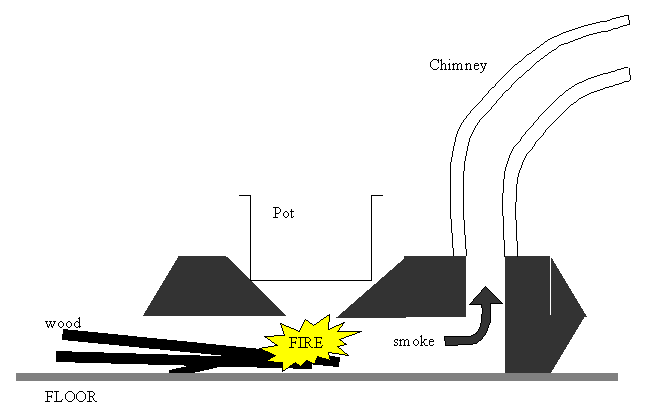
Shielded Three-Stone Fire
The shielded 3-stone
fire was made with the same mixture. First a three-stone fire was made, then it
was covered with mixture to make a wall as in the picture.


(cut in half
looking from the top) mixture
![]()

(Cut in half looking from the side)

Metal Woodstove
The metal stove was
made of steel in a workshop. This is how it looked.
Cut in Half from the
Side
Looking from the Outside

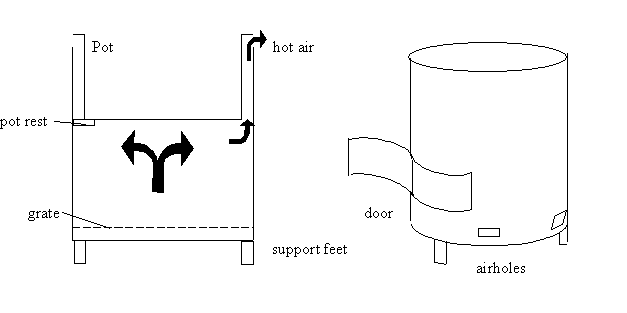
Three-Stone Fire
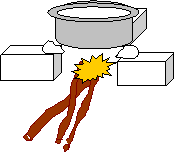
The three-stone fire was made with bricks; it
was used inside, like the other stoves.
Explanation – What is Measured and Why
It is difficult to give one number to say how good a stove is.
If you heat something, you must give it heat energy. There are many different types of energy (e.g. heat, light, electric energy). Energy can be changed from one type to a different one, but it cannot be made from nothing.
When a tree grows, it takes in light energy from the sun. The tree stores this energy in the wood. When a fire is started, the energy inside the wood is changed into heat. The heat should go into the pot of water (for example). Much of the heat does not go to the pot, but into the air, or into the walls of the stove. A good stove can send more heat into the pot because it stops the heat from going to the wrong place. If a stove uses little wood to cook, or to heat water, it has a high efficiency (that means it does not lose very much energy). If a stove has an efficiency of 20%, then 20% of the energy in the wood gets into the water in the pot, and 80% is lost. All stoves lose some energy, so there is no stove with 100% efficiency. In fact, most wood stoves have efficiency under 25%.
Usually, a stove gives a different efficiency when the wood is burning fast (high power) to when it is burning slowly (low power).
It is important for a stove to have a good efficiency at high power, so that a cook can heat a pot quickly at the start of cooking without wasting energy.
When the water (or food) starts boiling, it is at the maximum temperature it can be. In Kampala this is about 97°C. If the cook has a big fire under a pot of boiling water it will boil hard but it cannot get hotter than 97°C, and the food cannot cook faster. This means the cook is wasting energy. Therefore only a small fire is needed to just keep the water boiling (this is called simmering) but use little wood. The food will cook in the same time as with a big fire. So the stove must also be efficient at low power, so that it does not waste energy, especially when preparing food with a long cooking time (beans for example).
When finding efficiency or comparing stoves, it is often best to heat only water, not food. This is because the energy needed to heat water is known and it does not change. This means that water boiling tests can find numbers (like efficiency) that can be compared to other stoves tested in a different place at a different time. Food can change from one meal to the next, even if it has the same weight, and that can mean the test is not fair. Also, different food is cooked in different ways all over the world, so it is hard to compare meal cooking tests if they are not done in the same place in the same way. But it is also important to test the stoves with real food because the stoves must work well in real life, when they are used in the way a Ugandan cooks.
Three types of tests were done, the first and second using only water, and the third using food.
The first test is to find out how fast the stove can give energy to the water from the wood. This is measuring the maximum power (energy per second). It will also find the efficiency when the stove is used at maximum power. The water will be heated as fast as possible and boiled hard for 30 minutes
The second test is to find out how much wood the stove needs to boil water (starting from cold) and keep it simmering for 90 minutes. This is measuring the fuel consumption for a job needing high power and low power. The test will find out how much wood a three stone fire uses to do this job, and compare that with the other stoves. If a stove uses 30% less wood than the 3-stone fire, it gives a 30% saving.
The third test is to find out how much wood the stove needs to cook a meal and how much time it takes.
TEST ONE – HIGH POWER
Method;
How it was done
- About 3kg wood was weighed
-
3.5 kg
water was put in the pot, and the water temperature was taken
-
The stove
was lit
-
The pot
was put on the stove without a lid.
-
The water
was heated as fast as possible (at maximum power) until it was boiling. The
water temperature was taken every five minutes.
-
The water
was boiled at maximum power for 30 minutes
-
The fire
was put out with sand, and the water was weighed again quickly.
-
If some
black charcoal had been made, it was taken off the wood and weighed. The wood
was also weighed.
The Lorena has two pots, so when it was tested, the first pot was boiled
for 30 minutes as usual, and the second pot was heated at the same time with
2.5 kg water.
Tests were done 5 times to make sure the results were reliable. The
average result was used.
Results; How They are Worked Out, and What They
Mean
This test was to find the maximum power the stove can give to the water. Power is energy per second.
So the energy the water has taken must be found, and also the number of seconds needed to give that energy. Then power = energy / time.
Energy is measured in joules (J). In this test energy is needed to:
1. Heat the water
2. Turn some water into steam
4185 J are needed to heat 1 kg of water by 1°C. There are 3.5 kg of water in the pot, so if (for example) the water is heated from 25°C to 97°C (a rise of 72°C), it has taken 4185 * 3.5 * 72 = 1.05 million joules (or MJ)
That is the energy needed to heat the water, but energy is also used to turn water into steam, this happens very fast when the water is boiling. The water weighs less at the end of the test than at the beginning. The difference is the weight of water that has been turned to steam. It takes 2.3 million joules to turn 1kg of water to steam. So if the water has lost 0.5kg it needed 1.16 MJ.
The energy given to the water is the energy needed to heat the water plus the energy needed to turn some of the water into steam. In this example, that means:
Total energy given to the water = 1.05 MJ + 1.16 MJ = 2.21 MJ.
To find the power, divide the energy by the time taken (in seconds). If the test lasted for 45 minutes (2700 seconds) the power is 2.21MJ / 2700s = 819W. Power is measured in watts (W). One watt is one joule per second, a light bulb uses 60W.
The power the stoves gave is shown in the graph below
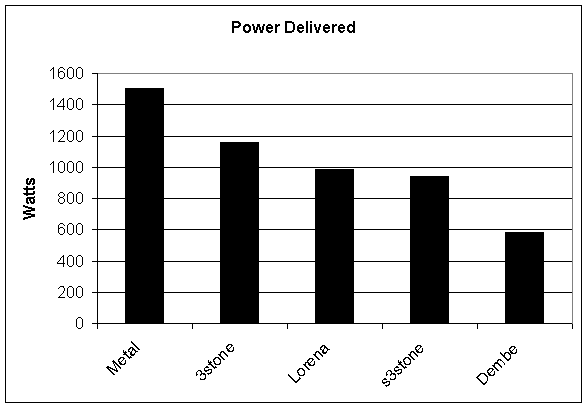
Now the maximum power of the stoves is known, so the efficiency at maximum power must be found. The efficiency is the percentage of energy in the wood that gets into the water. The energy that gets to the water is known (in our example it was 2.21MJ) so now only the energy in the wood is needed.
In dry wood there are 20million joules in one kg. If the wood is wet, there is less energy to use.
Firewood is never completely dry, so the water in the wood was measured. It was measured by first weighing a piece of wood, then drying it in an oven at 110°C for 12 hours. It was weighed again afterwards. The weight lost is the water that has come out of the wood. If the wood weighs 110grams before drying and 100grams after, then the wood has 10 % moisture content. The moisture is always written as a percentage of the dry weight (not a percentage of the weight of the wood before drying)
The wood used in the first test had a moisture content of around 14%. This means there are 18.9 million joules in 1kg of the wood.
So if 1kg of wood is used, 18.9MJ are used.
But some of this energy is not really used, because some wood is turned into charcoal. There is a lot of energy in charcoal, and this unused energy can be burnt later. That means we must find out how much energy is left in the charcoal, and make sure it is counted as energy “not used”. There are 30MJ in 1 kg charcoal. If 100g of charcoal are in the stove after the test, that is 3MJ not used. We will take this away from the energy used.
Energy in the
1kg wood which has “gone” minus energy in the charcoal
=energy used
If 2.21MJ of this energy gets into the water (as in the example) then the efficiency is
(2.21MJ / 15.9MJ)*100 = 11%
This means 11% of the wood energy gets to the water. (in our example). The efficiency is 11%.
The efficiency at maximum power for the real stoves is shown below
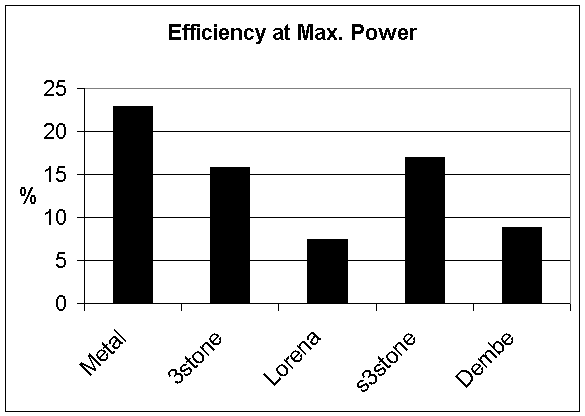
From the graphs it is clear that the metal stove gives the highest power. It is also the most efficient when used at high power. The 3-stone fire gave just over ¾ of this power and was less efficient. The Dembe gives a low power compared to other stoves, and both Dembe and Lorena give a very bad efficiency
All the stoves lose more than ¾ of the wood energy. Why?
The 3-stone fire loses energy to the air and heat escapes around the sides of the pot, especially if there is a wind.
The metal stove stops wind getting to the fire, and it pushes the hot smoke next to the pot sides, so more heat goes into the water. Some heat is used to make the stove hot. This does not go into the water. The metal stove is small and light, and gets hot very quickly, with little energy.
The Dembe and Lorena are very big and heavy, they need a lot of energy to warm up. The cold walls take energy away from the fire, the mud that is used to make them can carry heat away quickly. They also cool the fire so it cannot burn well, so some of the wood energy is not turned to heat. It is wasted. The cold walls may be a bigger problem at the start of the burning time. The Dembe has a chimney that sucks air through the stove. This can take the heat very quickly out of the chimney, before the hot air reaches the pot.
The shielded 3-stone fire also takes some heat into its walls, but it is not as big as the Lorena and Dembe, so less heat is needed to warm it.
TEST TWO – HIGH POWER HEATING AND LOW POWER
BOILING
Method
-
About 3 kg
wood was weighed
-
3.5 kg
water was put in the pot and the water temperature was taken
-
The stove
was lit.
-
The pot
was put on the stove, a lid was used to cover the pot
-
The water
was boiled as fast as possible (at maximum power). The temperature was taken
every five minutes.
-
Once the
water boiled, the fire was made smaller so the power was reduced to the minimum
needed to keep the water simmering. The water simmered for 90 minutes.
-
The fire
was put out with sand, and the water was weighed again quickly.
-
If some
black charcoal had been made, it was taken off the wood and weighed. The wood
was also weighed.
The Lorena has two pots, so when it was tested, the first pot was
simmered for 90 minutes as usual, and the second pot was heated at the same
time with 2.5 kg water. The water temperature was also taken in the second pot.
These tests were done with a lid, but the 3-stone fire was also tested
without a lid, to see if the lid makes any difference.
Tests were done 5 times to make sure the results were reliable. The
average result was used.
Results
This test was to find out how much wood is needed to boil the water and simmer it for 90 minutes.
As for test one, some charcoal was made. This holds some energy that has not been used. Charcoal holds more energy than wood. We worked out how much energy from the wood has really been used, by taking away the energy left in the charcoal.
The graph shows how much wood is needed to give the same energy. If you want to know the energy in joules, 1 kg wood = 18.86 MJ.
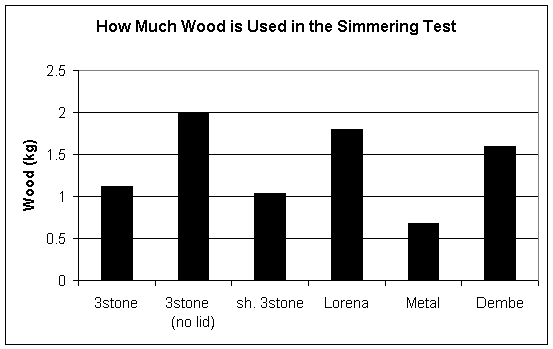
The metal stove has again given the best results. It used 700g of wood to heat and simmer the water for 90 mins. The shielded 3-stone fire used a little less wood than the traditional 3-stone fire, while the Lorena and Dembe used around 50% more.
The Lorena uses more wood to heat a pot of water and boil it for 90 minutes – but it is actually heating two pots. When you look at the graph, it shows how much wood is needed to heat and simmer one pot for 90 minutes. That is the information you want if you only want to use one pot. Often a cook wants to boil only one pot for a long time, and then add a second pot for tea or sauce for a short time. But sometimes the cook wants two pots to boil for a long time. When the Lorena is boiling the first pot, it is also heating a second pot. If we add the energy given to both pots in this test, the Lorena is nearly as efficient as the 3-stone fire.
If the traditional fire is compared to the other stoves, a percentage saving can be given. A saving of 10% means the stove uses 10% less wood than a 3-stone fire. Some stoves give a negative saving, meaning they use more wood than a traditional fire. The 3-stone fire always gives a saving of 0 (because saving 0 means “the same as the 3-stone fire”).
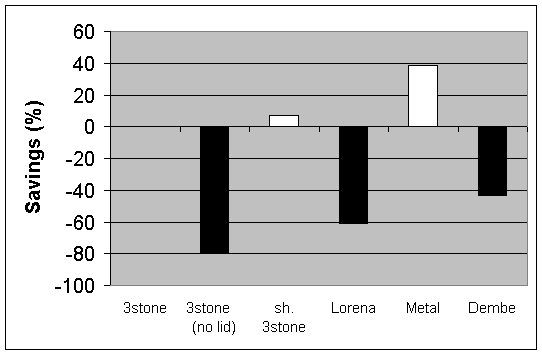
The most important thing to see here is that if the cook does not use a lid, she uses 80% more wood to do the same job. This means that using a lid is more important than using a good stove
So a lid can save energy. How?
First remember that
![]() water + heat energy
steam
water + heat energy
steam
and it is true backwards too:
![]() steam water + heat
energy
steam water + heat
energy
We know that energy is used to turn water to steam. When the pots were weighed after the test, the pot with a lid lost 0.4 kg water, and the pot without a lid lost 2.1kg. So the lid can catch the water and stop it from getting away to the air. It can do this because when steam touches the lid, the lid is colder than the steam. That means the steam turns to water again. When it turns to water it gives out energy (heat). That helps to warm up the lid, and the air inside the pot. It stops all the energy getting away with the steam. When you cook without a lid, you are letting too much energy get away with the steam. A lid helps to catch the steam and take back its energy.
You can also see that the Dembe and Lorena waste a lot of wood, even though they have some time to warm up in this test. The stoves do get warm, but they do not get warmer than the pot, so they cannot heat the pot
TEST THREE – MEAL COOKING
Method
The cooking was done by a Ugandan housewife. She decided how to cook,
how much power to use, and when the meal was ready.
-
2kg water
was put in the pot
-
400g
sticks from the back of banana leaves were put in the bottom of the pot
-
3kg peeled
matoke was weighed
-
1.5 kg
banana leaves was weighed.
-
The matoke
was wrapped in two big banana leaves and put in the pot.
-
The sauce
was prepared: 350g mashed G-nuts, 60g chopped onion, 160g chopped tomato 10g
salt and 1kg water was mixed in the small pot.
-
The small
pot (with lid) was put on top of the matoke in the big pot, and everthing in
the pot was wrapped with banana leaves and tied together.
-
The fire
was lit
-
The pot
was cooked as the cook wanted, it was first heated on high power. The power was
made lower when the water boiled, but it was not at minimum.
-
When most
of the water in the big pot was gone (boiled off), the cook said the meal was
ready. She knew this by listening to the boiling.
-
The wood
was weighed, and the charcoal was also weighed.
-
The food
was eaten! (to check it was cooked)
The Lorena has a hole for a small pot, so when it was tested the sauce
pot was not tied on top of the matoke, but cooked at the same time on the
second pot hole.
Results
The graph shows how much wood was needed to give enough energy to cook a meal on each stove. If some charcoal was made, that energy has been worked out in kg of wood and taken away from the wood used. Remember 1kg wood =18.86MJ

The results show nearly the same picture as before; the Dembe and Lorena use more wood than the 3-stone fire, but the shielded 3-stone and metal stoves use less. The same numbers are shown on the next graph, but it shows them as savings
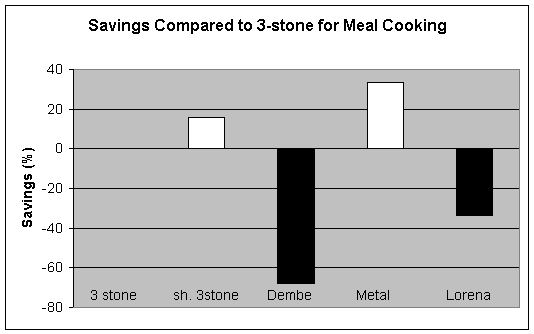
This graph shows more clearly that The Dembe uses nearly 70% more wood than the 3-stone fire to cook the same meal, but the Metal stove uses over 30% less. The Lorena does not waste as much as the Dembe, but it is still worse than the 3-stone fire. The shielded 3-stone fire saves about 15% of the wood needed for the 3-stone fire.
It is important to know how long the stove takes to cook, see the graph below.
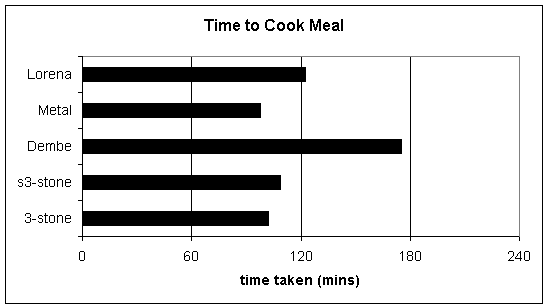
The metal stove, 3-stone fire, shielded 3-stone fire and Lorena are close together at about 100 minutes. Because they are close together, and because the tests change a little every time, especially when cooking food, we cannot be sure that they are not really the same. (see “How can the results be trusted”) page 30. The Dembe clearly takes much longer though, the cook must wait an hour more for dinner!
Why does the Dembe need a longer time than the other stoves?
This meal is cooked by turning water into steam, and the steam cooks the food. The cook knows the meal is ready when the water under the matoke has nearly all turned to steam (it is gone and she cannot hear it boiling).The water needs energy to turn to steam, and it needs high power to turn to steam fast. To do this, the cook makes quite a big fire, but not as big as for test one. She can choose how much power the stove should give, so she makes it give enough power to make steam fast, but not too fast (then the water is gone before the meal is ready). She wants all the stoves to give the same power. When she cooked with the 3-stone fire she burnt the wood 80% as fast as for test one. Test one showed that the Dembe cannot give 80% of the power the 3-stone gives. So it cannot give enough power to make steam as fast as the cook wants, and she must wait longer for all the water to boil away. The Dembe takes longer because it can only give low power.
Why does the Dembe use more wood?
The Dembe must cook for a longer time. Every minute the stove is burning, it is also losing energy – through the chimney, from the sides etc. So if it cooks for a long time it loses more energy and it must burn more wood to give that energy. That is why quick stoves use less wood; even though the Dembe used less wood than Lorena to boil water for 90 minutes in test two, it used more wood to cook a meal because it used more time.
This meal (Matoke and sauce) is very popular in Uganda, and it can be cooked with only one place for a pot. There are also meals which need two pots to be cooked (they cannot cook together). If two cooking places are needed, most of the stoves will take longer to cook – they must cook first one pot, then the other one, but the Lorena will save time, because it can cook two pots at the same time. So the results of this test are only for matoke and sauce cooked in the same way. Other meals must have their own test.
Making a Better Stove
Now we know the Lorena and Dembe have a problem, we must find a better
way to build a stove. To give a good efficiency, a stove must do two things
without wasting energy:
1. Change the energy in the wood to heat
To do this efficiently, the fire should be very hot. If it is not, some
of the wood will turn to smoke or black soot and it will not be changed to
heat. The problem with the Lorena and Dembe
is that they are made of mud (a lot of mud), and mud can take heat away too
quickly. The wall around the fire should stop heat and keep it in the right
place (insulate). Vermiculite or wood ash can do this, but not earth or mud. If
the heat cannot go through the walls, the fire will be hotter and burn better –
so it will make even more heat.
If it is possible, cold air
should not get to the fire, because it will make it colder. A hot fire is
better at changing all the wood energy to heat. But enough air is needed to let
the fire burn well. If the air can pass
through something warm before it comes to the fire, then it will be better at
keeping the fire hot.
Hot air moves up. So the air will go through the stove better if it can
move up inside the stove. If there is a space above the fire, air will move up
into it, and suck more air through the fire behind it. The wood should be
lifted up to let air come under the fire. It is possible for smoke to burn in
the space above the fire, giving more energy.
2. Get the heat into the pot
The heat should go into the pot. It can only do this through the bottom
or the sides. If it goes through the bottom and the sides, that will let
most heat through. This is what the metal stove does, it lets the hot air and
smoke touch all the outside of the pot.
In the Dembe, the hot air and smoke is quickly pulled to the chimney, it
does not go close to the pot. More heat will go into the pot if the hot air is
pushed very close to it. In the metal stove the stove wall is very close to the
pot side, that is good – more heat can pass through the pot.
The stove around the pot should also be insulated so more heat goes to
the pot, not through the walls.
These ideas are put together to make some new stoves. The rocket stove,
the improved shielded 3-stone fire and the Estufa Justa. The rocket stove is a
better metal stove, and the Estufa Justa is like a better Lorena.
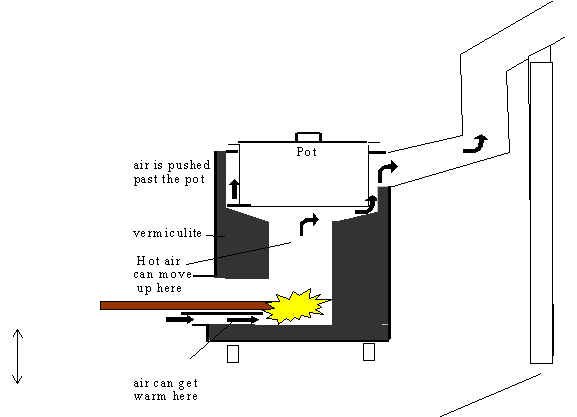
Rocket Stove
The Estufa Justa looks
like the Lorena outside, but inside it is different
Estufa Justa
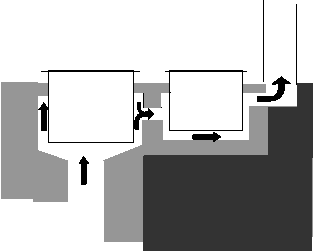
![]()
![]()
![]()
![]()
![]()
Insulation: vermiculite, wood ash
etc
![]() Earth, bricks etc.
Earth, bricks etc.
All the new stoves are made to fit the pot, the hot air has a small
space to move around the pot (about 1cm). The space under the pot is sloping to
let the air move better. They are insulated with a vermiculite and cement
mixture. They have a space over the fire for the hot air to move up into. The
wood is on a shelf so air can come in under it. They both have a chimney, the
pots must be on the stove or the chimney will not work.
Metal Stove with Chimney
![]()
 The metal stove used before was very efficient
and powerful, but it does not take away smoke. A chimney was put on this stove,
and a metal ring was put around the top of the stove to stop smoke coming out
into the kitchen.
The metal stove used before was very efficient
and powerful, but it does not take away smoke. A chimney was put on this stove,
and a metal ring was put around the top of the stove to stop smoke coming out
into the kitchen.
![]()
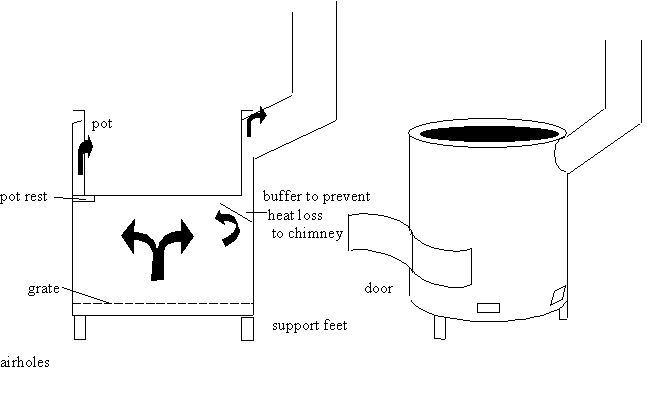
The shielded 3-stone fire saved some wood
in the tests. It is very simple and cheap to build. It was changed with a
vermiculite and cement mixture so it has the same parts as the rocket stove,
but no chimney. The sides of the stove were made higher, nearly as high as the
top of the pot.
Improved Shielded 3-stone Fire
Wood on a shelf
![]()

TESTING THE NEW STOVES
The stoves were tested
in the same way as before, and the efficiency and power are found in the same
way
Test One – High power
The efficiencies at
maximum power and the power delivered are shown below. The stoves tested before are also on the graph.
The stoves often used in Uganda are coloured black.
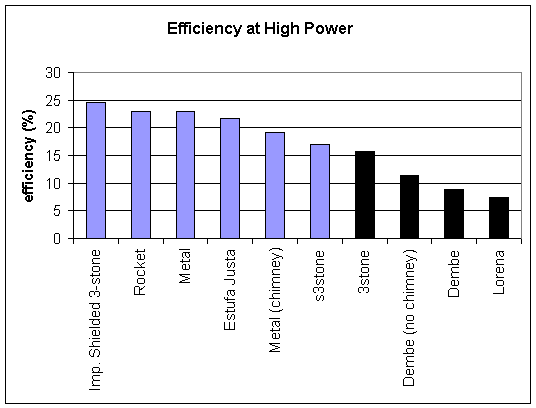
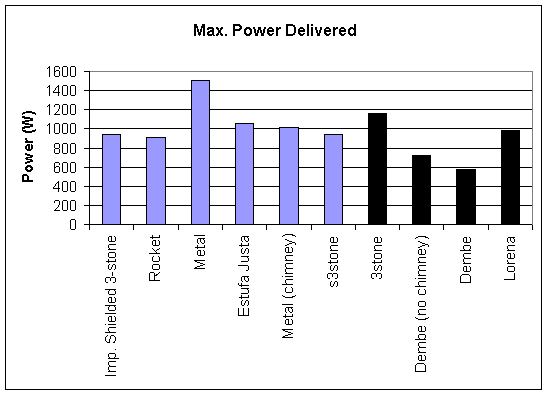 The new improved
designs have all given better efficiencies than the three-stone fire.
The new improved
designs have all given better efficiencies than the three-stone fire.
The shielded three-stone fire is the best, giving an efficiency just
under 25% and a power over 900W.
The Estufa Justa, or “improved Lorena” gives an efficiency over 3 times
that of the Lorena. However, the power given does not show that the power
delivered to the second pot was only 185W, probably not enough to cook food,
only to warm dish water. The gap around the first pot was made bigger, to 2cm,
that made the power to the second pot higher, nearly the same as the Lorena. If
this gap is made wider, the efficiency for the Estufa Justa goes down to17.5%,
but it is still much better than the Lorena.
The rocket stove has given a 23% efficiency; that is good, but its has
quite low power. Low power means it will take a long time to cook, so cooks may
not like it. The vermiculite/cement mix should be better at insulating than
earth, but it is not perfect and it can still take heat away. Also, the pot is
not very close to the fire, the power might be higher if the stove is made
shorter.
Putting a chimney on the metal stove made its efficiency lower. Many
people will think it is more important to take smoke away, even if the
efficiency is lower.
The Dembe has a better efficiency with no chimney, but it does not give
the user any good points, because it is less efficient than the three-stone,
and it does not take away smoke. There is no reason to use it. It is better to
use one of the other stoves in this report, or even a three-stone fire. The
Dembe will not have more tests because of this.
Test Two – Low Power
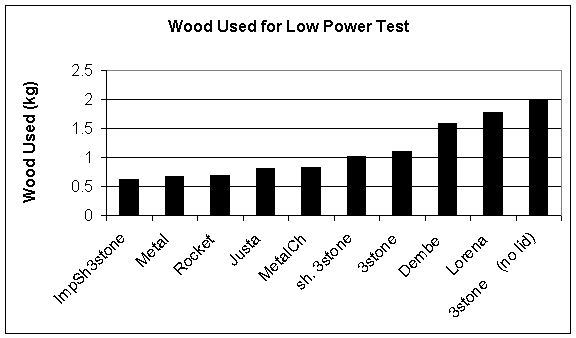
![]()
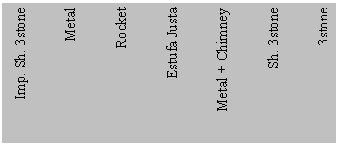
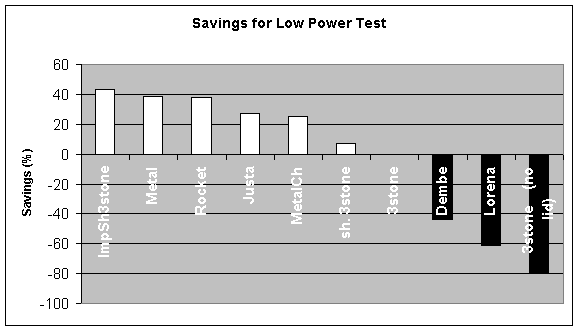
The improved
Shielded 3-stone, Rocket and Metal Stove all give good savings, at around 40%.
The test is a bit unfair to the Lorena and Estufa Justa stoves, because they
are heating two pots with the energy they use. If we count the energy in the
second pot as well, The Estufa Justa gives the highest efficiency. Also, the
water in the second pot got to about 85°C, higher than for the Lorena. If cooks think
the Lorena is good enough to cook two pots, then they will also think the
Estufa Justa is good enough. The metal stove can also give some savings, even
with a chimney attached.
Test Three – Meal Cooking
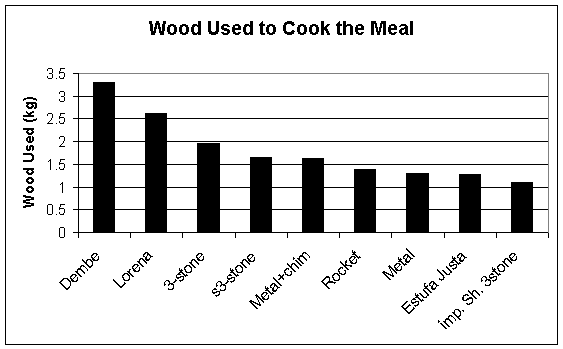
![]()

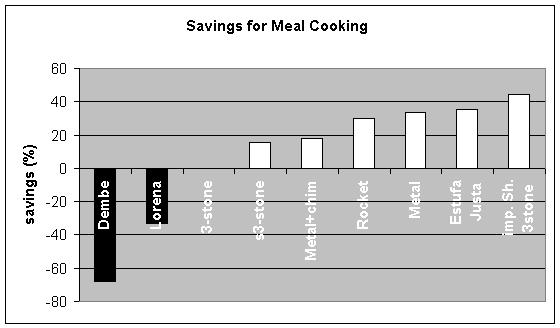
The improved shielded 3-stone fire has given the best fuel saving. The Estufa Justa and metal stoves also save more than 30%, with the rocket stove not far below. Adding a chimney to the metal stove means it uses more fuel, but it still gives some savings.
In test two, it was seen that the second pot on the Estufa Justa gets more power than the second pot on the Lorena. In the cooking test, it was found that the Justa second pot, with sauce, can only boil on one side. Cooks will probably not like this, so the stove should be changed to make the heat go all around the pot.
The times taken to cook are shown:
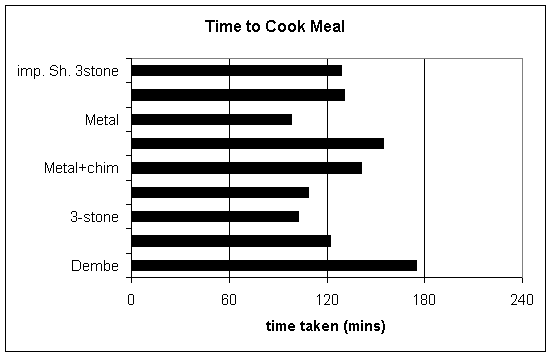
The cooking times are close together, at about two hours. However, the rocket has low power and that means a longer cooking time, it is not quite as slow as the Dembe. The new stoves do not show faster cooking times than the first stoves tested, even though they have better efficiency. Usually when someone is cooking, they do not need a very high power. In this meal, the cook did not use maximum power with most stoves, she controlled them. If a stove can give the power the cook wants, there is no reason to make it have higher power – it will not cook quicker because the cook will control it to cook at the right speed. But the Dembe and Rocket cannot cook at the best speed because of low power.
Results Reminder
The Improved
Shielded 3-stone, rocket, Estufa Justa and metal stove (with or without
chimney) all give a better efficiency than the 3-stone, and save fuel when
cooking. The Improved Shielded 3-stone saves most (43%), but it does not remove
smoke. The Lorena and Dembe do not save fuel, they use more than the 3-stone
fire. It is very important to use a lid when boiling water, without one, 80%
more fuel is needed.
Good and Bad Sides
This table is a list of some important good and bad things about the
stoves. To make a stove successful, it must have good sides to balance how much
it costs. When someone uses the stoves, she might save money on wood. After
some time she will save the same money she paid for the stove. Stoves projects
work best if this money is saved as soon as possible. In the table is the
number of months needed to save the cost of the stove by saving wood. This time
will be shorter for families which cook more (the meal cooked in the test was
for a small family). To find how much
money someone can save if they use the stove as long as possible, we need to
know how many years or months it lasts. That information must be found later,
using the stoves in real kitchens. The costs have been given by the producers,
but they are only to give an idea, they are not exact.
Stove
|
Good Sides
|
Bad Sides
|
Price (Ush) |
Months to save
money |
|
3-stone |
Efficiency OK if
used well. Size
of pot can change, can grill etc. Nice to sit around No mending needed Gives light and heat to room Women are used to it |
Does not take away smoke. Unsafe – fire risk, children |
0 - |
- |
|
Lorena |
Takes away
smoke Mud is from near the
village. Two
pots Safe -no hot sides
People know it |
Not efficient Cannot
change pot sizes much |
10 000-30 000 |
never |
|
Dembe |
Takes away smoke Mud is from near the
village.
Safe -no hot sides Can change
pot size |
Very slow Not efficient |
8000- 25 000 |
never |
|
Shielded 3-stone |
Saves some wood Mud
is from near the village.
|
Does not remove
smoke and not portable. |
5 000- 10 000 |
3 |
|
Metal stove |
Efficient Can carry it Looks like traditional stove |
Does not take away smoke Unsafe – hot
sides. Cannot change pot size |
5000 |
1.5 |
|
Metal Stove with
Chimney |
Fairly efficient Takes away smoke |
Hot sides Cannot change pot size |
8000 |
4 |
|
Rocket Stove |
Efficient Takes away smoke 1 or 2 pots |
Cannot make it in
the house New, strange design Cannot change pot size Low power |
25 000 |
7 |
|
Estufa Justa (“New
Lorena”) |
Efficient Takes away smoke 2 pots Looks like lorena |
Cannot get
vermiculite everywhere. Builders must be trained. 2nd pot
heated on one side. |
20 000 |
5 |
|
Improved Shielded
3-stone |
Very efficient No hot sides |
Does not take away
smoke and cannot be used outside (rain) Entrance not strong |
8000 |
2 |
Some of the stoves bad sides
might be helped by more testing and small changes, the rocket stove and Estufa
Justa for example. If a mud wall is built around the metal stove (but not
touching it) children will be protected from hot sides. The improved shielded
3-stone is best if used outside (no walls), but under a roof. The entrance for
wood is not strong enough if it is vermiculite, so a metal tube can be used,
like in the rocket stove. Stoves with
walls cannot be used for everything a three-stone fire can do, for example
roasting maize and giving light, but this is a difficult problem to solve.
Taking away smoke is
an important reason to use a stove. But in the beginning, when the fire is
started, the pot is not on the stove. That means smoke comes into the room.
Also, smoke can sometimes come out of the door to the metal stove, or even the
Lorena and Estufa Justa if the wind is strong.
So the new stoves are better in many ways than the old ones, but they
are not perfect. They should be changed and tested with the advice of users and
promoters.
The good sides of a stove must
balance against the bad sides, and different people want a stove to do
different things.
How Can the Results be Trusted?
It is impossible to measure anything exactly in the real world. If this page is 30cm high when a ruler is used to measure it, with a better ruler it could be 30.01cm. So there is always a possible “error” for a measurement. This error depends on many things, the ruler (or clock, or other measuring tool) is never completely right (imagine the page is 30.000000002cm). Even if the clocks and thermometers used in this experiment are completely right (they are not), the result will not be exactly the same for every experiment, even if they are all done in the same way. The efficiency of the stoves depends on many things; the way the wood burns, the air temperature and many more. So the five results for the same test are all a little different because of small unseen changes. This means that an average (middle) efficiency is used.
If the average efficiency for the 3-stone fire is 15% and for the shielded 3-stone fire it is 16%, how can we know that the 1% difference is really because of the stoves, not just because of the small changes we cannot see in the experiment?
We look at the five results for the same test for each stove, For example, the 3-stone might be 15.3, 15.6, 15.0, 14.8 and 14.6. Then the average is 15. Now we find out how different each number is from the average result for that stove. For example 15.3 is 0.3 different from the average. This can tell us (with some mathematics) a top number and a bottom number. For example we can say that the efficiency of the 3-stone is 15% but that it can be somewhere between 15½ % and 14½ % . If another stove gives 16% then we will say it is really better (the difference is “significant”), it is not likely that it has the same efficiency but gives a different result because of the small unseen changes. How do we work out the ½ % ? There are different ways to do this, In this report the “standard error” equation is used. It uses the number of results (we have used five), and the differences between them. This equation is explained in maths or science books.
The errors in these tests were usually small enough to say that stoves which give different results really are different. But in test three, the cooking time of many stoves is very close – some of the errors we worked out are bigger than the time differences. That means we must say the results are not significantly different, and they might really be the same. In a scientific report, the errors should always be given, or the numbers cannot be trusted. All the errors for the results are drawn as extra lines in graphs in the longer report. “A Comparison of Wood Burning Cookstoves for Uganda”.
CONCLUSION
Important Points
- A cook who does not use a lid uses 80% more energy (wood). Everyone working in energy saving should be told this. This is even more important than the type of stoves that are promoted. Maybe it is hard to promote lids alone, but lids and good stoves can be promoted at the same time.
- Dembe and Lorena stoves use much more wood than a 3-stone fire. If an organisation wants to help people use less wood, it should not promote them. The Lorena and Dembe do take the smoke away, this can be the only reason to use them, but other stoves also take smoke away and are better. We must be sure that villagers do not stop trusting improved stoves, so this information should be used carefully. The good things about new stoves should be explained, not the bad things about old ones.
- The Estufa Justa is an improved Lorena. It can save a lot of wood when cooking (35%). The rocket stove also saves wood, but it should be improved to make the power higher. It is expensive though, which may be a problem. The improved shielded 3-stone gives the best savings and it is not expensive, but it does not remove smoke. Even so, because it burns efficiently, it does not make much smoke.
- A metal stove can save wood, and it is a little faster than a 3-stone fire. It does not have a chimney, but it can be easily carried outside, where the smoke is not so dangerous to the cook. This stove could be promoted in Uganda, if it can fit with Ugandan culture.
- The metal stove can have a chimney, but then it is not quite so efficient, it saves only a little.
· There are some ideas which are important in making an efficient stove. For example, it should be insulated, the hot air should be pushed all around the pot sides, and enough air should reach the fire.
- Earth is not an insulator. Heavy earth stoves like Lorena and Dembe take in too much heat to the body, so it does not get into the pot. A vermiculite mix is better, but other mixtures may be found, like clay and sawdust. This should be tested later
·
If someone wants to promote a
new stove, it must be tested first. This is because when users are asked how
much wood they use with the new stove, they might try to be polite, or they
just repeat what they were told when they were given the stove. Some of them might
think they are using the stove badly, so they say they save wood to be the same
as other users. If the promoters give tips when they give out stoves (to use a
lid, for example) then that can be the real reason for fuel saving, not the
stove.
What Should We Do Next?
Many people have done a lot of work to promote Lorena and Dembe stoves,
but even though these stoves do not save wood, they should not think they have
only wasted time. It is very important that people in villages and towns know
that they can save energy. The work done with the Lorena has told them this.
Maybe now it is easier to bring in new stoves because people are more ready to
use improved stoves. It is the idea of improved stoves which has been a
success.
Now we should try to use this success. Most people think the Lorena is
very good. It is better to promote the Estufa Justa stove, and say it is a “new
Lorena” than to say the Lorena is a bad stove. It is important to make sure the
people can trust the idea of improved stoves.
Now there is a lot of work to do so that Uganda can develop its stove
projects, and Ugandans can start to cook more efficiently. We must work
together as quickly as possible to change, so that time and money is not used
on projects which do not work.
The groups working with woodstoves should meet to talk about the results
found. They can make the new stoves they like, and let some people use them.
Maybe group members and housewives can try them. If possible some people in the
areas where stoves are sold should also try them. The users should say what
they like or do not like about the new stoves. After that the groups can meet
again and talk about changes to make.
If the stoves are changed so that
cooks like them, they will sell more. When they are changed, the efficiency
will be better if they still have the parts talked about in the chapter on new
stoves. For example; insulation, hot air around the pot sides, and the wood
lifted on a shelf. If people do not like the parts that make the stoves
efficient, maybe some efficiency must be lost. If possible, the stoves should
be nice to use without making the efficiency much lower. The changed stoves
should always be tested before selling them. This is very important, because
sometimes even a small change can make the efficiency very different.
In fact, the stoves might need to be changed many times. Every time a
new change is made, it is then tested and sold or given to some users. The
users give advice on how to make it better, and then there is a meeting to
decide what to change. If everyone shares information and ideas, all the stoves
groups in Uganda can improve their programmes quickly. If someone finds some
scientific information, or does a user survey, another group can put it
together with other information and make better designs, or a better way to
promote.
Some groups might already have stoves which they think are good, and
they do not want to start making different ones. They can work with us to test
the stoves they have, maybe they are not as good as they think, or maybe they
are even better – tell everyone about them!
Some groups might want to make their own new designs, if they test them
in a scientific way, they can be sure if they have a good design, and they can
prove it and share the information.
The Ministry of Energy will continue testing stoves in Uganda, to give a
fair way to compare stoves here. Contact the ministry to get more information
at:
Ministry of Energy and Mineral Development PO box 7270 Kampala, Uganda
There are many changes which could be made to the stoves, and your ideas
are welcome. Here are some possible
changes to try.
Estufa Justa:
1) Remove metal rings around pots and use clay or vermiculite mix instead.
2) Use ceramic pot holes around pots, Lorena earth outside and underneath (see diagram) Fill spaces with wood ash, which is good insulation and cheap.
Estufa Justa 2
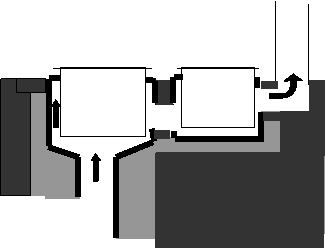
![]()
![]()
![]()
![]()
![]()
![]()
Insulation: wood ash etc
![]() Earth, bricks etc.
Earth, bricks etc.
![]() Ceramic liner (or iron for
firebox etc)
Ceramic liner (or iron for
firebox etc)
3) Change air channel between pots to let heat get to all sides. (see diagram). Keep the channel between the two pots as short as possible
![]()
![]()
Estufa Justa 3
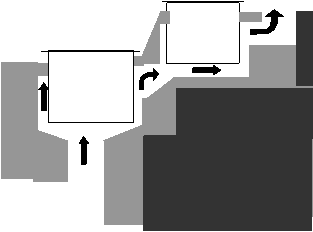
![]()
![]()
![]()
![]()
4) Combine ideas in 2 and 3
5) Try clay and sawdust mixture instead of cement and vermiculite
6) Find best height for space above fire. Tall means good burning efficiency but poor heat transfer efficiency, and lower power.
7) Find best width for gaps around pots.
8) Find best diameter for chimney
Wider gaps around the
first pot mean more heat for the second, but probably lower overall efficiency.
If it is too good at
taking all the heat from the smoke, the smoke will not be hot enough to leave
up the chimney, or (more likely) it will drop lots of poisonous soot in the
chimney. If it is metal, it will start to “eat” the chimney because it is acid.
If the chimney sucks
well enough, the smoke should not escape into the room, even if the pots do not
fit 100% perfectly. Make a block to stop wind blowing smoke the wrong way
through the stove.
Wood ash should give
better insulation than vermiculite. The higher the proportion of vermiculite in
the vermiculite/cement mix, the better the insulation (but not strength).
Imp. Shielded 3-stone
- Strengthen entrance tube (metal/ceramic)
- Use ceramic liner in same way as suggested
for Estufa Justa.
- Bricks are used in the design. If the pot
stands on the bricks, the stove might be stronger, it should be strong
enough to mix posho (maize porridge)
Metal
- Make the door smaller
- Make the stove taller so the flames do not
touch the pot
- Build a wall from mud around it (not
touching it) to protect children etc.
If you want advice on how to test, contact GTZ Kampala at simonis@africaonline.co.ug , or
e-mail Emma George at emma@george.
More Information
Some information I
have used on stoves came from other reports. Many of them are on the internet.
Barnes et al (1994) What
Makes People Cook with Improved Biomass Stoves – A comparitive international
review of stove papers. World Bank Technical Paper 242 Energy Series
DFID (2000) Poverty
reduction aspects of successful improved household stove programmes DFID
KaR R7368
Forest Department of
Uganda, (1993) Uganda National Biomass Study Report Kampala, Uganda.
Gill, J (1985), Stoves
and Deforestation in Developing Countries
Mayondo, A. (2001) Comparison
of Brick Lorena Cook stoves and Traditional Stoves in Kitagweda County
NEMA, (2001) State
of Environment Report for Uganda
Prasad and Verhaart
(1983) Wood Heat for Cooking Indian Academy of Sciences
Rouse, J. (1999) Improved
Biomass Cookstove Programmes: Fundamental Criteria for Success. MA Dissertation,
University of Sussex.
Shanahan (1982) Stoves
and Deforestation in Developing Countries at www.odi.org
Still, D and
Winiarski, L. (2001) Increasing fuel efficiency and reducing harmful
emissions in traditional cooking stoves. Boiling point magazine, No. 47
Still, D et al. (1996) Fuel Efficient Wood Stoves:
Efficiency of Combustion, Operator Expertise and Heat Transfer Efficiency.
Still, D. From La
Lorena to La Estufa de Dona Justa. Aprovecho centre web page: www.efn.org/~apro
Tata (1982) Wood
Conserving Cookstoves : a Design guide (out of print)
World Bank (1992) World Development Report
Good Internet Sites
A good place to start
is to look at these internet sites. Most of them have good links to more
information.
www.efn.org/~apro (START HERE! Look at “appropriate
technology”) These are the people who first designed and made the Lorena.
www.cookstove.net Lots of information on testing methods
www.crest.org
http://villageearth.org/atnetwork/atsourcebook/chapters/energycookstoves.htm
For a list of books and reports on stoves.
If you want to send
e-mails to many stoves experts, you can join a big list at stoves@crest.org Just send an empty e-mail to that address,
you will start to get mails and you can also send them.